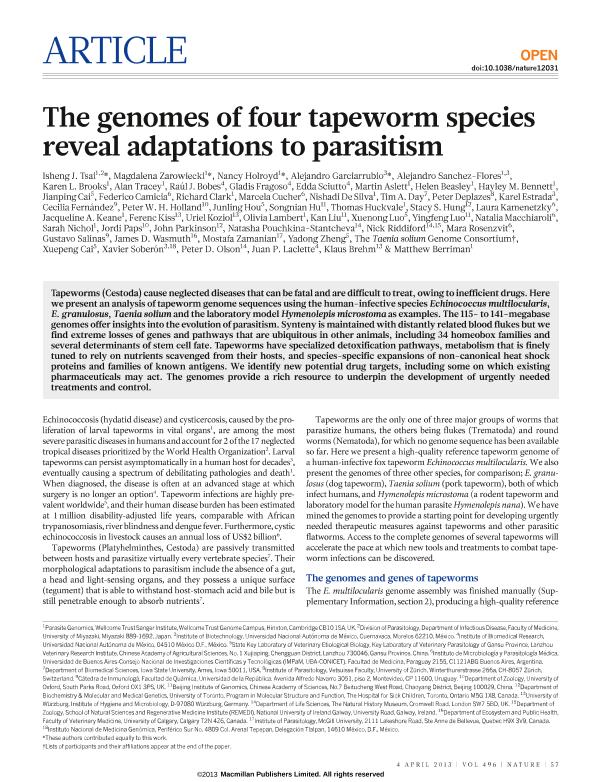Artículo
The genomes of four tapeworm species reveal adaptations to Parasitism
Tsai, Isheng J.; Zarowiecki, Magdalena; Holroyd, Nancy; Garciarrubio, Alejandro; Sanchez Flores, Alejandro; Camicia, Federico ; Cucher, Marcela Alejandra
; Cucher, Marcela Alejandra ; Kamenetzky, Laura
; Kamenetzky, Laura ; Macchiaroli, Natalia
; Macchiaroli, Natalia ; Rosenzvit, Mara Cecilia
; Rosenzvit, Mara Cecilia ; Liu, Kan; Luo, Xuenong; Luo, Yingfeng; Nichol, Sarah; Paps, Jordi; Parkinson, John; Pouchkina Stantcheva, Natasha; Riddiford, Nick; Salinas, Gustavo; Wasmuth, James D.; Zamanian, Mostafa; Zheng, Yadong; The Taenia Solium Genome Consortium; Cai, Xuepeng; Soberón, Xavier; Olson, Peter D.; Laclette, Juan P.; Brehm, Klaus; Berriman, Matthew
; Liu, Kan; Luo, Xuenong; Luo, Yingfeng; Nichol, Sarah; Paps, Jordi; Parkinson, John; Pouchkina Stantcheva, Natasha; Riddiford, Nick; Salinas, Gustavo; Wasmuth, James D.; Zamanian, Mostafa; Zheng, Yadong; The Taenia Solium Genome Consortium; Cai, Xuepeng; Soberón, Xavier; Olson, Peter D.; Laclette, Juan P.; Brehm, Klaus; Berriman, Matthew
 ; Cucher, Marcela Alejandra
; Cucher, Marcela Alejandra ; Kamenetzky, Laura
; Kamenetzky, Laura ; Macchiaroli, Natalia
; Macchiaroli, Natalia ; Rosenzvit, Mara Cecilia
; Rosenzvit, Mara Cecilia ; Liu, Kan; Luo, Xuenong; Luo, Yingfeng; Nichol, Sarah; Paps, Jordi; Parkinson, John; Pouchkina Stantcheva, Natasha; Riddiford, Nick; Salinas, Gustavo; Wasmuth, James D.; Zamanian, Mostafa; Zheng, Yadong; The Taenia Solium Genome Consortium; Cai, Xuepeng; Soberón, Xavier; Olson, Peter D.; Laclette, Juan P.; Brehm, Klaus; Berriman, Matthew
; Liu, Kan; Luo, Xuenong; Luo, Yingfeng; Nichol, Sarah; Paps, Jordi; Parkinson, John; Pouchkina Stantcheva, Natasha; Riddiford, Nick; Salinas, Gustavo; Wasmuth, James D.; Zamanian, Mostafa; Zheng, Yadong; The Taenia Solium Genome Consortium; Cai, Xuepeng; Soberón, Xavier; Olson, Peter D.; Laclette, Juan P.; Brehm, Klaus; Berriman, Matthew
Fecha de publicación:
03/2013
Editorial:
Nature Publishing Group
Revista:
Nature
ISSN:
0028-0836
e-ISSN:
1476-4687
Idioma:
Inglés
Tipo de recurso:
Artículo publicado
Clasificación temática:
Resumen
Tapeworms (Cestoda) cause neglected diseases that can be fatal and are difficult to treat, owing to inefficient drugs. Here we present an analysis of tapeworm genome sequences using the human-infective species Echinococcus multilocularis, E. granulosus, Taenia solium and the laboratory model Hymenolepis microstoma as examples. The 115- to 141-megabase genomes offer insights into the evolution of parasitism. Synteny is maintained with distantly related blood flukes but we find extreme losses of genes and pathways that are ubiquitous in other animals, including 34 homeobox families and several determinants of stem cell fate. Tapeworms have specialized detoxification pathways, metabolism that is finely tuned to rely on nutrients scavenged from their hosts, and species-specific expansions of non-canonical heat shock proteins and families of known antigens. We identify new potential drug targets, including some on which existing pharmaceuticals may act. The genomes provide a rich resource to underpin the development of urgently needed treatments and control.
Palabras clave:
Genome
,
Adaptation to Parasitism
,
Tapeworm
Archivos asociados
Licencia
Identificadores
Colecciones
Articulos(IMPAM)
Articulos de INSTITUTO DE INVESTIGACIONES EN MICROBIOLOGIA Y PARASITOLOGIA MEDICA
Articulos de INSTITUTO DE INVESTIGACIONES EN MICROBIOLOGIA Y PARASITOLOGIA MEDICA
Articulos(OCA HOUSSAY)
Articulos de OFICINA DE COORDINACION ADMINISTRATIVA HOUSSAY
Articulos de OFICINA DE COORDINACION ADMINISTRATIVA HOUSSAY
Citación
Tsai, Isheng J.; Zarowiecki, Magdalena; Holroyd, Nancy; Garciarrubio, Alejandro; Sanchez Flores, Alejandro; et al.; The genomes of four tapeworm species reveal adaptations to Parasitism; Nature Publishing Group; Nature; 496; 7443; 3-2013; 57-63
Compartir
Altmétricas



